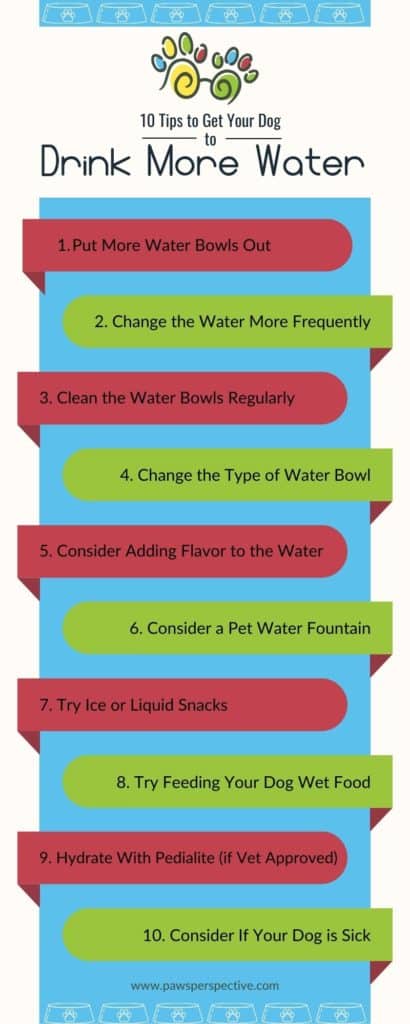I had first mom syndrome, where I took my dog to the vet without considering other options. When I first became a dog parent (unlike when I was little and my mom looked after the dog’s needs), I was pretty paranoid when my dog didn’t drink water. To my shock and delight, I learned that there are a few things I can try before taking my dog to the vet.
The best thing you can do if your dog doesn’t want to drink water is:
- Put More Water Bowls Around to Improve Accessibility
- Change the Water More Frequently
- Clean the Water Bowls Regularly
- Change the Type of Water Bowl
- Consider Adding Flavor to the Water
- A Pet Water Fountain Could Do the Trick
- Give Your Dog Ice or Liquid Snacks During the Day
- Try Feeding Your Dog Wet Food
- Hydrate Your Dog With Pedialyte if Your Vet Gives Permission
- Consider if Your Dog is Sick
How Much Water Should A Dog Drink Each Day?
When considering if your dog drinks enough water, the first thing to know is how much they should consume in a day. The amount of water your dog should drink in 24 hours depends on your dog’s body weight. So, get the scale-out and measure how many pounds your dog weighs.
A dog should drink about 1 ounce of water for every pound they weigh. That is approximately 1/8 cup of water for each pound of weight.
(infographic for each size group, e.g., small breed ranges, etc.)
How to Get Your Dog to Drink Water Before Getting Too Worried

Okay, so before you get too concerned that your dog isn’t getting enough water, see if you can coax them into drinking more water by yourself first. This way, you can eliminate any fussy behavior before thinking about the worst possible scenario.
1. Put More Water Bowls Around to Improve Accessibility
Where you put your bowl might be inconvenient for your dog. For example, it might get too much sun, is obstructed by furniture, or they don’t feel comfortable drinking water in that spot. So, to avoid this, put more water bowls around so your dog can drink wherever they’re comfortable.
2. Change the Water More Frequently
It’s good to change your dog’s water every day to prevent bacteria and algae from multiplying in the bowl. Not only can these organisms make your dog sick, but your dog might not like their taste. Also, some dogs are fussier about other dogs’ drool in the bowl and would avoid drinking it. So, ensure that there is clean water in the bowl every day.
3. Clean the Water Bowls Regularly
Just like the water can get dirty, so can the water bowls. If you see a slimy film layer or discoloration inside the bowl, you should clean it more often. A colorless slimy layer is a bacterial build-up. In contrast, a greenish layer is algae, which can make your dog lose interest in drinking from that bowl.
4. Change the Type of Water Bowl
Your dog could also be fussy about the bowl’s material. Some dogs prefer stainless steel bowls, whereas others might prefer ceramic bowls. And suppose the bowl has a porous material or gets scratched easily, like plastic. In that case, it can absorb and cling to microorganisms that impact the water’s taste. So, you can consider playing around with different water bowls to see what your dog prefers.
A study from Hartpury University in the UK proved that “Potentially fatal bacteria, including E.coli, salmonella, and MRSA, which can all be transferred from pets to their owners, have been discovered in different types of dishes that are commonly sold.”
5. Consider Adding Flavor to the Water
Some dogs don’t like the taste of certain waters. Their taste buds are so sensitive that the slightest chemical build-up can keep them from drinking water. My youngest Cocker Spaniel, Joey, was like that. So, you could try adding dog-friendly flavoring to the water to entice them to drink more. Some people put a little bone broth inside, and others buy flavoring drops to mix with the water daily.
6. A Pet Water Fountain Could Do the Trick
Because water is motionless in a typical dog bowl, it can attract more impurities or organisms, putting a dog off drinking water. But, when you use a pet water fountain, it keeps the water moving, filters through impurities, and keeps the water cool. Not only that, but it is also an entertaining way for a dog to drink water.
7. Give Your Dog Ice or Liquid Snacks During the Day
You can also try to give your dog more snacks during the day that contain fluids. For example, you can freeze bone broth in ice trays and give your dog a few cubes during the day. Or, you can provide them with the bone broth liquid to drink. When you do this, ensure that you don’t exceed your dog’s daily calory needs; otherwise, they can become overweight without you noticing why.
8. Try Feeding Your Dog Wet Food
You can consider giving them wet food instead of dry kibble. As the name suggests, wet food contains more liquid that can help keep your dog hydrated, whereas dry food doesn’t provide hydration at all. It can cause slight dehydration because the dry kibble absorbs excess water in your dog’s saliva and stomach, not leaving enough for your dog’s body to absorb for daily functions.
9. Hydrate Your Dog With Pedialyte if Your Vet Gives Permission
If you’re still concerned that your dog isn’t getting enough water, consider giving your dog Pedialyte. It is an electrolyte used as a human hydration tool but is also safe for dogs. Many dog owners use this if they have active dogs at higher risk of losing fluid through panting and sweating.
However, before you try this, ensure that you get the okay from your vet and the correct dosage. You don’t necessarily have to go to the vet; phone them to make sure.
Caution: if your dog seems dehydrated and lethargic, see your vet immediately. Severe dehydration can be fatal to dogs.
10. Consider if Your Dog is Sick
If you’ve tried everything you can, but your dog still doesn’t want to drink water, consider if there’s a medical reason. If that’s the case, a checkup with your vet won’t hurt! And to know if you should be concerned, see if there are other symptoms accompanying your dog’s unwillingness to drink water. The first signs you will see are signs of dehydration.
Read this article on the type of questions your vet will ask about your dog.
“These questions aren’t random. It helps your vet figure out what illness, injury, or situation they’re dealing with and how to help the dogs to the best of their abilities. It’s a way of getting to know the dog and its environment, routines, exposure, and risk factors.”
Juan’Ri Strauss|Paws Perspective
The Paws Perspective
It’s always important to consider every aspect of your dog’s daily routine to know when there’s something seriously wrong or if they’re just fussy. As a dog parent, it’s your job to advocate for your dog because they can’t speak for themselves!
But also trust your gut! You know your dog the best and see their routines and habits daily. If you feel something is wrong, be safe rather than sorry. So, it’s ultimately up to you whether you should make lifestyle adjustments to get your dog to drink more water or whether a health checkup is necessary.
You’re doing good, and I’m so proud that you educate yourself on anything that could make your dog’s life better and more fulfilling!
